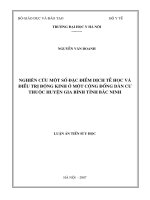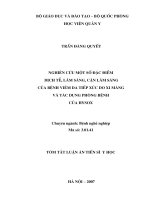nghiên cứu một số đặc điểm dịch tễ, lâm sàng viêm phổi không điển hình do vi khuẩn ở trẻ em bản tóm tắt tiếng anh
Bạn đang xem bản rút gọn của tài liệu. Xem và tải ngay bản đầy đủ của tài liệu tại đây (295.37 KB, 31 trang )
MINISTRY OF EDUCATION AND TRAINING MINISTRY OF
HEALTH
THE NATIONAL INSTITUTE OF HYGIENE AND EPIDEMIOLOGY
PHAM THU HIEN
THE STUDY OF EPIDEMIOLOGICAL
CHARACTERISTICS, CLINICAL MANIFESTATIONS
OF ATYPICAL PNEUMONIA CAUSED BY BACTERIA
IN CHILDREN
Science: Epidemiology
Code: 62 72 01 17
1
SUMMARY OF THE DOCTORAL DISSERTATION
HA NOI - 2014
2
The project was completed at the
National Institute of Hygiene and Epidemiology
The scientific advisors:
1. Prof. Dao Minh Tuan
2. Prof. Phan Le Thanh Huong
Reviewer 1:
Reviewer 2:
Reviewer 3:
The dissertation will be defended at the meeting hall of the
National Institute of Hygiene and Epidemiology.
In… hours, …/… / 20….
3
The dissertation is available at:
1. The National Library
2. The National Institute of Hygiene and Epidemiology
4
LIST OF THE PUBLICATIONS BY THE
AUTHORS RELATED TO THE DISSERTATION
1. Pham Thu Hien, Dao Minh Tuan, Nguyen Phong Lan,
Phan Le Thanh Huong (2011), "The role of Mycoplasma
pneumoniae, Chlamydia pneumoniae, and Legionella
pneumophyla in community -acquired pneumonia in children:
preliminary results", Journal Journal preventive Medicine,
Vol. XXI, No. 7 ( 125 ), pp. 62-69.
2. Pham Thu Hien, Dao Minh Tuan, Nguyen Phong Lan,
Phan Le Thanh Huong( 2012 ) , " Causes, clinical features ,
clinical manifestations of atypical pneumonia in children " ,
Journal of Medical Research , episode 80 , No. 3 A , pp. 119-
124 .
3. Pham Thu Hien, Dao Minh Tuan, Nguyen Phong Lan,
Phan Le Thanh Huong (2012), "Frequency , clinical
characteristics , subclinical pneumonia caused by
Mycoplasma pneumoniae, Chlamydia pneumoniae in
children ", Journal Journal preventive Medicine, Vol. XXII,
No 6 (133), tr 31 - 38.
5
LIST OF ABBREVIATIONS
ALT Alanine Aminotransferase
AST Aspartate Aminotransferase
BCYE buffered charcoal yeast extract
C. pneumoniae Chlamydia pneumoniae Chlamydia pneumoniae
CRP C protein reactive Protein C phản ứng
Cs Cộng sự
ELISA enzyme-linked
immunosorbent assay
Kỹ thuật miễn dịch gắn
men
IgG Immunoglubulin G Immunoglubulin G
IgM Immunoglubulin M Immunoglubulin M
IL Interleukin Interleukin
INF Tumor necrosis factor Yếu tố hoại tử u
L. pneumophila Legionella pneumophila Legionella pneumophila
M. pneumoniae Mycoplasma pneumoniae Mycoplasma
pneumoniae
PCR polymerase chain reaction Phản ứng PCR
PPLO Pleuropneumonia like
organisms
Pleuropneumonia like
organisms
Real – time PCR Real –time polymerase
chain reaction
Phản ứng Real – time
PCR
S. pneumoniae Streptoccocus pneumoniae Streptoccocus
pneumoniae
TNF Tumor necrosis factor Yếu tố hoại tử u
VPĐH Viêm phổi điển hình
VPKĐH (AP) Atypical pneumonia Viêm phổi không điển
hình
WHO World Health Organization Tổ chức y tế thế giới
6
ABSTRACT OF THE DISSERTATION
1.Background
Atypical pneumonia is frequent in developing countries. However,
the studies about these conditions in developing countries, including
Vietnam are limited. Forest (2007) reported that the incidence of
atypical pneumonia in the community-acquired pneumonia was 22 % in
the United States and 91% of those had been treated. In Europe, the
incidence of atypical pneumonia was 28%, the rate of treatment was
74%. In Latin America, the incidence of atypical pneumonia was 21%
and the rate of treatment was 57%. In Asia / Africa, the incidence was
20%, the rate of treatment was 10%.
The diagnostic methods for atypical pneumonia include: bacterial
culture in the special media, serology, and polymerase chain reaction
method. Polymerase chain reaction method (PCR) has helped confirmed
and rapid diagnosis bacterial pathogens. In Vietnam, PCR techniques are
available in only few hospitals in central and major medical centers. Most
treatments have been done with empirical therapy that may result in
increasing in antibiotic resistant, and prolonged treatment time.
Little is known about the epidemiology, clinical and laboratorial
manifestations of atypical pneumonia in children, including the diagnostic
techniques for bacterial causes of atypical pneumonia such as multiple
primers PCR (multiplex-PCR) and enzyme-linked immunosorbent assay
(ELISA), we conducted the study: "The study of epidemiological
characteristics, clinical manifestations of atypical pneumonia caused by
bacteria in children”. The study objectives were:
1. To describe the epidemiological characteristics, clinical manifestations
of atypical pneumonia caused by Mycoplasma pneumoniae, Chlamydia
pneumoniae, and Legionella pneumophila in children who were treated
at the National Hospital of Pediatrics in Hanoi, Vietnam from 07/2010
to 3/2012.
7
2. To identify the factors associated with the severity of atypical
pneumonia in children.
2. New contribution to the science
- This project was the first study to identify the prevalence of atypical
pneumonia caused by M. pneumoniae, C. pneumoniae and L.
pneumophila, co-infection rate of pneumonia in hospitalized children
- The study has identified several factors associated with severity of
atypical pneumonia. Co-infection with bacteria and viruses was the
related factors for severe atypical pneumonia.
- This study described the clinical manifestations and laboratorial
characteristics of atypical pneumonia, atypical pneumonia co-infection
in children.
3. Practical value of the subject
- Evaluate the results of clinical manifestations and laboratory
characteristics of atypical pneumonia to draw specific symptoms which
suggesting early clinical diagnosis, help clinicians quickly optimal
decision the choice of antibiotic therapy and have a more
comprehensive view of the causes of pneumonia in children.
- The study's results are significant in establishing the pattern of
microorganisms which cause respiratory infections in children, and to
guide treatment and prevention strategies.
- Microbiological diagnostic techniques based on molecular biology (only
in a few specialized laboratories) will be confirmed and efficient which
can be replicated in the laboratory of clinical microbiology.
4. The structure of the dissertation
The dissertation consists of 128 pages including: Background and
objectives: 2 pages; Literature review: 34 pages; Methods: 18 pages;
Results: 34 pages; Discussion: 37 pages; Conclusion: 2 pages, and
recommendation: 1 page. There are 29 tables and 20 figures, 228
references including 22 in Vietnamese, 206 documents in foreign
languages.
Chapter 1. OVERVIEW
1.1. Introduction
Atypical pneumonia: pneumonia caused by M. pneumoniae has
been recognized from the dairy failed to sulfonamides or penicillin used
8
to treat pneumonia, help to distinguish pneumonia pathogens M.
pneumoniae pneumonia or pneumococcal (pneumococci). The failure
to respond to antimicrobial therapy has been thought as "atypical"
(atypical). This term, along with "Walking around pneumonia" is used
broadly to refer to respiratory disease caused by M. pneumoniae in
humans. Then other agents cause similar clinical picture was included
in the group of atypical pneumonia as C. pneumoniae, L. pneumophila
1.2. Epidemiological characteristics of atypical pneumonia caused by
Mycoplasma pneumoniae, and Legionella pneumophila
Chlamydia pneumoniae
1.2.1. Epidemiology characteristics of pneumonia caused by
Mycoplasma pneumoniae
Disease appears in all countries, however studies about the disease
mostly have been carried out in the United States, Europe and Japan.
In the U.S, infection caused by M. pneumoniae accounts for 15-20% of
all community-acquired pneumonia. Especially in the summer time, M.
Pneumonia can reach up to 50% of all community-acquired pneumonia.
During 2010 to 2012, an outbreak of M. pneumoniae infection
happened in some Asian countries. A multicenter study in Asia in 2005
found that M. pneumoniae was an important cause of the community
acquired pneumonia, which accounted for 22.3%.
Disease occurs in people of all ages, predominant in the age group
from 5-9 years old.
Disease can occur throughout the year, and the peak during the
period from late summer to early fall.
The bacteria can live everywhere in nature, transmitted from
person to person via the respiratory tract. The average Incubation period
is 3 weeks. After suffering from this disease, an immune survived about
4 years. Immunology temporary and recurence.
1.3.2. Epidemiology characteristics of Chlamydia pneumoniae
pneumonia
C. pneumoniae infection distributes over the world. A study
from 10 different regions of the world showed a higher frequency in
tropical populations. In the U.S. and many other countries, the sero-
prevalence of C. pneumoniae infection was of 50% of total population.
9
Estimated number of cases of pneumonia caused by C. pneumoniae in
the United States is 300,000 cases per year. Globally, prevalence of
pneumonia caused by C. pneumoniae from 4337 patients was 8% in
North America, 7% in Europe, 6% in Latin America and 5% in Asia
Forest (2007).
The disease affects both genders and all age groups. Disease
occurs throughout the year, and gets its peak during summer time.
Infectious reservoir is humans, and it is transmitted through
respiratory secretions directly exposed to coughing, sneezing. After
suffering from this disease, patients have an immune temporarily and
recurrent frequently. Disease cycle every 4 - 8 years.
1.3.3. Epidemiological characteristics of Legionella pneumophila
pneumonia
Legionella disease occurs worldwide. The majority of cases
disease been identified in tropical countries. In the U.S., about 8000-
18000 hospitalized cases every year. In Europe, the prevalence of
Legionella infection were 5,907 cases in 2007 and 5,960 cases in. 2008.
Most patients exposed to L. pneumophila but no symptoms. The
risk increase in an older people. Children after ages 4 rare occurs
pneumonia due to L. pneumophila.
Legionella live everywhere, special in the aquatic environment, the
disease transmitte through tiny droplets of water vapor. Disease is not
transmitted from person to person. Incubation period 2 -10 days. Re-
infection occurs in immunocompromised people.
1.4. The clinical features, laboratory manifestations and treatment
of pneumonia caused by M. pneumoniae, C. pneumoniae and L.
pneumophila.
1.4.1. The clinical features of pneumonia caused by M. pneumoniae,
C. pneumoniae, L. pneumophila
M. pneumoniae, C. pneumoniae is causative agents of pneumonia
with the various degree of severity. Majority of patients appear with
mild illness and self-recover. Few patients progress to severe condition,
acute respiratory failure and death.
The common pulmonary manifestations are: eardrum inflammation,
rash, urticaria, pleurisy, thrombocytopenia, meningitis, and mild anemia.
10
The extrapulmonary manifestations are rare: hemolytic anemia,
coagulation disorders, thrombosis, pulmonary abscess, pneumothorax,
burnout syndrome, pericarditis, myocarditis, Stevens Johnson
syndrome, neurological manifestations: meningitis, encephalitis,
mental disorders, Guillain – Barre syndromes, cerebellar ataxia, the
brainstem, like polio.
L. pneumophila causes two distinct disease entities: pneumonia
and Pontiac fever. Pontiac fever is usually mild, patients may have
fever, muscle-aches, no pneumonia, no need treatment. Legionella
disease may have clinical manifestations including abnormalities in the
central nervous system (headache, mental confusion, encephalopathy,
coma), cardiac abnormalities(relatively slow heart rate), gastrointestinal
manifestations (target diarrhea, abdominal pain), liver damage (liver
enzymes) and kidney(microscopic hematuria, increased creatinine),
electrolyte abnormalities (assuming m and decreased serum sodium
phosphate).
Extrapulmonary manifestations of Legionella can present with the
damage in spleen, liver, kidney, heart, bone and bone marrow, joints,
inguinal lymph nodes, nervous and digestive tract.
1.4.2. Laboratory manifestations of pneumonia caused by M.
pneumoniae, C. pneumoniae and L. pneumophila
Chest X-ray (CXR):
Radiographic manifestations of atypical pneumonia can be
extremely variable and can mimic with a wide variety of lung diseases.
The inflammatory response causes interstitial mononuclear cell
inflammation that may be manifested radiographically as diffuse,
reticular infiltrates of bronchopneumonia in the perihilar regions or
lower lobes, usually with a unilateral distribution, and hilar adenopathy.
Bilateral involvement may occur in about 20% of cases.
Bacteriological tests
- Blood culture: L. pneumophila can be isolated from blood
culture with low sensitivity.
- Gram stain: L. pneumophila start gram paler color when dyed. M.
pneumoniae results because bacteria do not have cell walls so they do not
color when dyed.
11
Respiratory secretions culture: by using a special medium (PPLO
broth environmental bacterium M. pneumoniae culture, environment
chick embryo cells or mice, Hella 229 and cultured Hep 2 find C.
pneumoniae; BCYE environment - Buffered Charcoal Yeast Extract Agar
detect L. pneumophila culture). L. pneumohila usually grows after 3-5
days, M. pneumoniae usually results after 7-21 days later.
Serological methods: the methods are: complement fixation technique
(Complement Fixation - CF), immunofluorescence technique (Immuno
Fluorescence Assay - IFA), Enzyme-linked immunosorbent technique
(Enzyme Immuno Assay - EIA), particle agglutination technique
(partical Agglutination - PA).
Antigen detection methods:
The tests include direct immunofluorescence, free electrolyte cell
convection, infiltration and immune enzyme immunoassay.
PCR (Polymerase Chain Reaction).
PCR is a continuous chain reaction, including many successive
cycles, each cycle consisting of three phases: denaturation phase;
annealing stage; synthesis stage. PCR primers to test multiple
simultaneous detection of atypical pathogens such as C. pneumoniae,
M. pneumoniae, L. pneumophila. Results showed that Multiplex -
PCR assay is sensitive, useful, cheap and quick assay diagnosis for
patients pneumonia.
1.4.3. Treatment of pneumonia caused by M.pneumoniae, C.
pneumoniae and L. pneumophila
M. pneumoniae bacterium do not has wall, C. pneumoniae,
L.pneumophila are intracellular bacteria therefore all antibiotics belong to
beta-lactam groups are not effective. They are sensitive to the macrolide
antibiotics such as erythromycin, clarythromycin, azithromicin,
tetracycline and quinolones. However, tetracycline is not indicated for
children under 8 years of age and quinolone not indicated for children
under 15 years of age.
1.5. Studies of atypical pneumonia, severe atypical pneumonia in
children and related factors
1.5.1. Current research on atypical pneumonia in children
12
1.5.1.1. In the World
Worldwide, coincides water poses by M. pneumoniae, C.
pneumoniae encountered in the upper respiratory tract and lower
respiratory tract, which occurs in both adults and children. L.
pneumophila causes severe disease in adults, it occurs rarely in
children under 4 years of age.
1.5.1.2. In Vietnam
Some research interest in disease incidence and clinical features of
pneumonia caused by M. pneumonia among hospitalized children in some
provinces of Vietnam only. Molecular biology techniques are deployed in
some centers, large hospitals nearly.
1.5.2. Studies of severe atypical pneumonia and related factors
1.5.2.1. Etiological bacteria
Pneumonia caused by L.pneumophila that disease is second,
followed by pneumococcal pneumonia requiring intensive treatment.
For people with normal immune systems, the mortality rate is usually in
the range of 10-15%.
1.5.2.2. Coinfection status
Co-infection status was considered as aggravating factors in
community-acquired pneumonia in adults has been demonstrated by
Gutiérrez: pleural effusion, atelectasis, septic shock, hypoxemia
requiring mechanical ventilation, death in patients with pneumonia due
to coinfected patients higher than agent patients (OR = 2.84, 95% CI
1.24 to 6.54, p = 0,02).
1.5.2.3. Accompanying diseases
Studies in adults show that with diseases such as asthma, chronic
obstructive pulmonary disease, malignancies, cardiovascular, diabetes,
immunosuppression are factors that increase the severity of the disease.
1.5.2.4. Specific treatment late
Specific treatment late is emphasized associated with significant
mortality in adults suffer from pneumonia caused by L. pneumophila.
According to Gacouin A., duration of illness before admission to the
ICU for more than 5 days (OR 7:46, 95% CI 1.17 to 47.6) were risk
factors for mortality of L . pneumophila pneumonia.
13
1.5.2.5. Extrapulmonary manifestations
Atypical pneumonia with severe extrapulmonary manifestations
such as neurologic manifestations, hemolytic, heart disease,
polyarthritis, skin lesions, electrolyte disorders, multiple organ failure
related to status severe, even fatal.
1.5.2.6. The other factors
Concerning the situation of severe atypical pneumonia, such as the
relationship between bacterial load, drug resistance of M. pneumoniae
to macrolides, leucocytosis, lung injury 2 sides, pleural effusion,
increased levels of LDH, ALT, AST, and decreased blood protid;
increased IL6, TNF, respiratory failure, mechanical ventilation, Lower
serum sodium <136 mEq / l, Paco
2
/ FiO
2
<130 ureanemia > 30 mg /
dl,albuminemia decreased, multiple organ failure, requiring mechanical
ventilation, complications of lung abscess, wall chemistry, effusion
related lung deterioration, mortality of the disease.
Chapter 2. METHODS
2.1. Study subjects
- Patients with pneumonia caused by different microbial agents, aged
from 12 months to 15 years old who were treated at the Respiratory
Department of the National Hospital of Paediatrics from 7/2010 to 3/2012.
- Patients with atypical pneumonia due to at least one of the three
studied bacteria: M. pneumoniae, C. pneumoniae và L. pneumophila,
aged from 12 months to 15 years old who were treated at the Respiratory
Department of the National Hospital of Paediatrics from 7/2010 to 3/2012,
referred to “ atypical bacterial pneumonia”.
- Patients with atypical pneumonia due to at least one of the three
studied bacteria: M. pneumoniae, C. pneumoniae và L. pneumophila,
were diagnosed severe atypical pneumonia.
2.2. Inclusion criteria
2.
- Pneumonia were diagnosed by using the WHO's criteria:
cough, fever, tachypnea, infiltration on chest radiograph.
2.2.2. Atypical bacterial pneumonia case
Patients were diagnosed with pneumonia
-Three bacteria M. pneumoniae, C. pneumoniae and L.
pneumophila were confirmed by Multiplex PCR in bronchial secretions
14
or nasopharyngeal or throat swab positive for the three studied
bacterias, or ELISA: double the serum samples were positive for one of
three studied bacterias.
2.2.3. Severe atypical pneumonia case.
Children were diagnosed with severe atypical pneumonia entitled to
classify pneumonia and WHO standards and the Association of
Pediatric Infection of the America.
- Patients with atypical pneumonia due to at least one of the
three studied bacteria.
- The severity of pneumonia was determined by the criteria for
severe pneumonia of the American Association of Pediatric Infection .
a. One or more major signs: required mechanical ventilation; sepsis
b. Or at least two of the following signs: tachypnea, apnea,
consciousness disorders; hypotension; pleural effusion, SpO
2
<90%
with room air and Pao
2
/ FiO
2
ratio < 250; many pulmonary infiltrates.
2.2.4. Exclusion criteria:
- Typical pneumonia
- Co-infection cases of pneumonia will not be considered for the
clinical characteristics, laboratory manifestations.
- Hospital- acquired pneumonia
- Patient s
’
families without agreed to participate in the study.
2. 3. Methodology
2.3.1. Study Design: epidemiology descriptive case series and analysis
study
15
Sample sizes for objective 1: WHO calculated by estimating the
percentage - a group
2
2/1
2
).(
)1(
ε
α
p
pp
Zn
−
=
−
where n is the minimum sample size, Z (1 - α / 2) is the coefficient of
reliability, corresponding to 95% confidence level we have Z
(1 - α / 2)
= 1.96. p
dependence incidence of pneumonia by M. pneumoniae, C.
pneumoniae, L. pneumophila, estimated in prospective studies on the
incidence of atypical pneumonia in hospital (in this study the rate of p
= 18% = 0.18). q = 1-p = 1 18 = 0.82; p.ε accuracy desired sample, choose
ε = 0.16. A required minimum sample size was 718 patients. We did
enrolled 722 patients for this study.
16
Sample sizes for objective 2
The purpose of the study is to describe a case series and combine
with the analytic study to identify factors associated with severe
atypical pneumonia cases, we used all cases diagnosed with atypical
pneumonia (215 patients) that occurred during the study period (7/2010
- 3/2012), among them, 97 cases were clasified as severe atypical
pneumonia.
2.3.2. Sampling method:
Source of patients:
Children from 12 months to 15 years, with an initial diagnosis of
pneumonia, treatment in National Hospital of Pediatrics from the local
different provinces.
Sampling method fore objective 1:
A convenient sampling technique, as a rule, chose one patient from
2 patients ( k=3),according to data pneumonia in hospitalized patients in
the preceding year divided by the total study minimum sample size
was calculated) apply to case series research, prospective, longitudinal
follow-up.
Sampling method fore objective 2: a convenient sampling
technique, take the whole 215 atypical pneumonia patients were
selected by criteria subjects for the study objective 1. From 215 cases
with atypical pneumonia, we selected 97 cases with severe atypical
pneuonia and 118 non- severe atypical pneumonia cases. We
conducted a comparative analysis to determine the factors associated
with severe atypical pneumonia among patients who were treated at the
National Hospital of Pediatrics. The data collection was performed
during the study, but the final analysis was carried out only at the end
of the study when all clinical, liboratorial and microbiology data was
collected for all patients.
2.4. Study variables
2.4.1. Study variable for objective 1
Epidermiological data collection
Demographic data: name, age, sex, location, education, information
family.
Epidemiological factors: geography, season, habitat, level of income
History: obstetrics, development, immunization, disease history
Clinical data collection: by interviewing parents and/or by physical
examination.
17
Laboratory data collection
The laboratory tests included blood specimens for counting
leukocyte (WBC), C-reactive protein (CRP), IL6 and for the detection
of IgM, IgA, IgG, IgE antibody and IgM antibody against M.
pneumoniae, C. pneumoniae and L. pneumophila.Throat
swabs/bronchial exudates were used for detection of M. pneumoniae, C.
pneumoniae and L. pneumophila specific DNA by multiplex PCR. In
addition, RT-PCR was applied to determine the presence of co –
infections involving other viral respiratory pathogens such as
Adenovirus, Respiratory Syncytial Virus (RSV), Rhinovirus, Influenza
A & B(RNA extraction using Qiamp Viral RNA Mini kit, RT-PCR
using Kit SuperSckip III One- Step Kit [Invitrogen].
2.4.2. Study variable for objective 2
Factors associated with severe atypical pneumonia: time from
onset to admission, antibiotic use before admission, signs, clinical
symptoms, WBC, CPR, IL6, IgA, IgM, IgG, IGE antibody, coinfected
status with severity of disease.
2.5. Data analysis
Statistical analysis was performed using Stata.10, SPSS.13,
Epidata 3.1.
Chapter 3. RESULTS
3.1. Epidemiological characteristics of Atypical bacterial
pneumonia in children.
3.1.1. General epidemiological characteristics of atypical pneumonia
Table 3.1. The rate of common pneumonia
Type of pneumonia The number
of
Rate%
Typical pneumonia caused by bacteria 82 11.35
Viral pneumonia 80 11.08
Pneumonia caused by typical bacteria co-
infection with virus
14 1.93
Atypical bacterial pneumonia 215 29.8
Pneumonia with unknown etiology 331 45.84
Total 722 100
Table 3.1. shows the overall incidence of atypical pneumonia was
29.8% of the total pneumonia.
18
Table 3.2. Classification of atypical pneumonia
Classification of atypical pneumonia
The
number
of
Rate %
Atypical
pneumonia
Atypical simple pneumonia: or M.
pneumoniae, or C. pneumoniae, or L.
pneumophila
144 67
Atypical pneumonia coinfection: by
M. pneumoniae and C. pneumoniae
or M. pneumoniae and L.
pneumophila or C. pneumoniae and
L. pneumophila
10
Coinfected
atypical
pneumoni
a
Outside
group
Atypical pneumonia + typical bacterial
pneumonia
38 17.67
Atypical pneumonia + viral
pneumonia
19
8.84
Atypicalpneumonia + typical
pneumonia + viral pneumonia
4
1.86
Total 215 100
Table 3.2 shows the co-infection rate was 33%, which co-infected with
typical pneumonia and viral pneumonia accounted for 28.37%.
Table 3.3. classify of pneumonia cases by agent bacterial atypical
pneumonia (data not shown here): it found that M. pneumoniae
was the most predominant among community acquired
pneumonia in 26.3%; C. pneumoniae and L.pneumophila detected
with low rate (3.7%, 1.8%).
19
Chart 3.1. Age distribution of typical pneumonia and atypical
pneumonia
Chart 3.1 shows that the proportion of children aged greater than 5 years
old with atypical pneumonia was 23.3%. But among 215 patients with
atypical pneumonia The incidence of children aged higher in the group
under 5 years old. The age variables were significantly difference (p
< 0.001).
There was no difference in gender distribution among children
with atypical pneumonia (data not shown)
Chart 3.3. Seasonal distribution of atypical pneumonia
Atypical pneumonia occurs throughout all seasons, more frequent
during spring-summer seasons than Auturm - Winter season. There was
statistically significant difference with p = 0.003 (χ
2
test).
20
Spring Summer Auturm Winter
Table 3.11. Factors associated with co-infection
Characteristics Adjusted OR 95% CI p
Age
Under 2 years
1 - - -
>2 years - 5 years old
0.79 0.39 1.58 0.50
> 5 years - 10 years
0.46 0.19 1.12 0.09
> 10 years old
0.43 0.08 2.48 0.35
Gender
Female
1 - - -
Male
1.81 0.94 3.48 0.07
Family economic conditions
Non-poor households
1 - - -
Poor households
1.37 0.54 3.47 0.51
Method of birth
Vaginal delivery
1 - - -
Caesareans
2.12 1.05 4.30 0.037
Asthma
Yes
1 - - -
No
0.73 0.29 1.84 0.50
Nutritional status
Normal
1 - - -
Wasting
1.82 0.77 4.29 0.17
Overweight and obesity
0.83 0.38 1.81 0.63
Test fit the Hosmer-Lemeshow test pattern n = 215, p = 0.8619
Table 3:11 shows the relationship between co – infected status
and each of variables, including age, gender, family economic
conditions, method of birth, asthma disease, nutritional status.
Except for Caesarean section, the other variables were not
significantly associated with co - infection (OR = 2.12, p = 0.037).
21
3.1 Table 2. The functional symptoms of hospitalized atypical
pneumonia patients (data not presented here): signs dyspnea in
coinfected atypical pneumonia outside group higher statistical
significance compared with atypical pneumonia in group (p <0,05).
Chart 3.7. Physical symptoms in the lungs of atypical pneumonia
patients
Examination finding moisture and crackles among coinfected
atypical pneumonia outside group higher statistical significance
compared than atypical pneumonia in group (p <0.05) (Figure 3.7).
Increased work of breathing signs among coinfected atypical
pneumonia outside group higher statistical significance compared than
atypical pneumonia in group (p <0.001).
Chart 3:10. Chest X-ray characteristics of the study subjects
Lobar consolidation with coinfected atypical pneumonia outside
group was significantly lower compared to the atypical pneumonia in
group (p = 0,05). Pleural pneumonia among coinfected atypical
pneumonia outside group as higher statistical significance than the
atypical pneumonia in group (p = 0,05).
22
3.1.3. Characteristics of atypical pneumonia analyzed by bacterial pathogens
Table 3:18. functional symptoms of atypical simple pneumonia
Clinical
Characteristics
Atypical
pneumonia by
M. pneumoniae
Atypical
pneumonia by
L. pneumophila
Atypical
pneumonia by
C. pneumoniae
n = 29
Rate
%
n = 7
Rate
%
n = 8
Rate
%
Fever 122 94, 57 6 85, 71 7 87, 5
Cough 129 100 7 100 8 100
Headache 37 28.68 3 42.86 2 25
Chest Pain 25 19.38 2 28.57 2 25
Wheeze 84 65.12 4 57.14 4 50
Hoarseness 42 32.56 4 57.14 3 37.5
Table 3:19. Physical symptoms of atypical simple pneumonia
Clinical
Characteristics
Atypical pneumonia
by
M. pneumoniae
Atypical
pneumonia by
L. neumophila
Atypical
pneumonia by
C. pneumoniae
n = 129
Rate
%
n = 7
Rate
%
n = 8
Rate
%
84 65.12 5 71.43 3 37.5
Crackles
9 0.69 1 14.28 0 0
Rhonchi 72 55,81 3 42.86 4 50
Intercostal muscle
external traction
40 31 2 28.57 0 0
Dyspnea 61 47,29 4 57.14 2 25
No rales 45 34,88 2 28.57 4 50
Consolidation
20 15.5 0 0 2 25
Pleural Effusion
2 0.16 0 0 1 12.5
Pneumothorax
0 0 1 14.28 0 0
Table 3:18 and 3:19 shows the distinct functional – physical symptoms
between L. pneumophila,C. pneumoniae and M. pneumoniae did not
differ significantly (p > 0.05).
23
3.2. Some risk factors of severe atypical pneumonia
Table 3.23. Association between obstetric history, history of nurturing
and developing of severe atypical pneumonia
Factors OR 95% CI p
Method of birth
Vaginal delivery 1 - - -
Caesareans 1.75 0.94 3.27 0.076
Congenital malformation of the circulatory system
No 1 - - -
Yes 3.73 0.38 36.48 0.257
Congenital malformation of respiratory system
No - - - -
Yes - - - -
Mental development
Normal 1 - - -
Retardation 4.02 1.25 12.91 0.02
Motor development
Normal 1 - - -
Delayed 5.93 1.64 21.48 0.01
Having asthma
No 1 - - -
Yes 1.58 0.73 3.39 0.24
Immunization
Enough 1 - - -
Not enough 5.21 1.08 25.16 0.04
Nutritional status
Normal 1 - - -
Wasting 1.25 0.59 2.68 0.55
Overweight and obesity 0.99 0.51 1.91 0.97
Table 3:23. through univariate analysis the likelihood of severe
atypical pneumonia includes: history of mental retardation (OR = 4.02,
p = 0.02), children with a history of delayed motor development (OR =
5.93, p = 0. 01); Children with a history of inadequate vaccination (OR =
5.21, p = 0.04).
24
Table 3.24. Association between etiologies and severe atypical
pneumonia
Factors OR 95% CI p
Etiologic bacteria
M. pneumoniae
1 - - -
C. pneumoniae
1.12 0.36 3.46 0.848
L. pneumophila
1.82 0.56 5, 97 0.321
Co-infection
1.49 0.52 4.29 0.461
Co-infection
Atypical pneumonia in group
1 - - -
Coinfected AP outside group
4.42 2.33 8.41 <0,001
Type of co-infection
Atypical pneumonia in group
1 - - -
Atypical + typical pneumoniae
4.55 1.98 10.9 <0.0001
Atypical pneumonia + virus
4.01 1.32 13.52 0,005
Atypical pneumonia + virus +
typical pneumonia
5.56 0.43 294.5 0.101
Table 3:24 showed: the likelihood of severe atypical pneumonia
includes: co-infected atypical pneumonia (OR = 4:42; p <0.0001);
atypical pneumonia co-infected with typical pneumonia (OR = 4.54, p
<0.0001), atypical pneumonia co-infected with virus (OR = 4.01, (p
<0,05).
25

![[Luận văn]nghiên cứu một số đặc điểm dịch tễ bệnh tiên mao trùng do trypanosoma evansi ở trâu bò tại lạng sơn và biện pháp phòng trị](https://media.store123doc.com/images/document/13/gu/fy/medium_f0Xtm90Z30.jpg)







